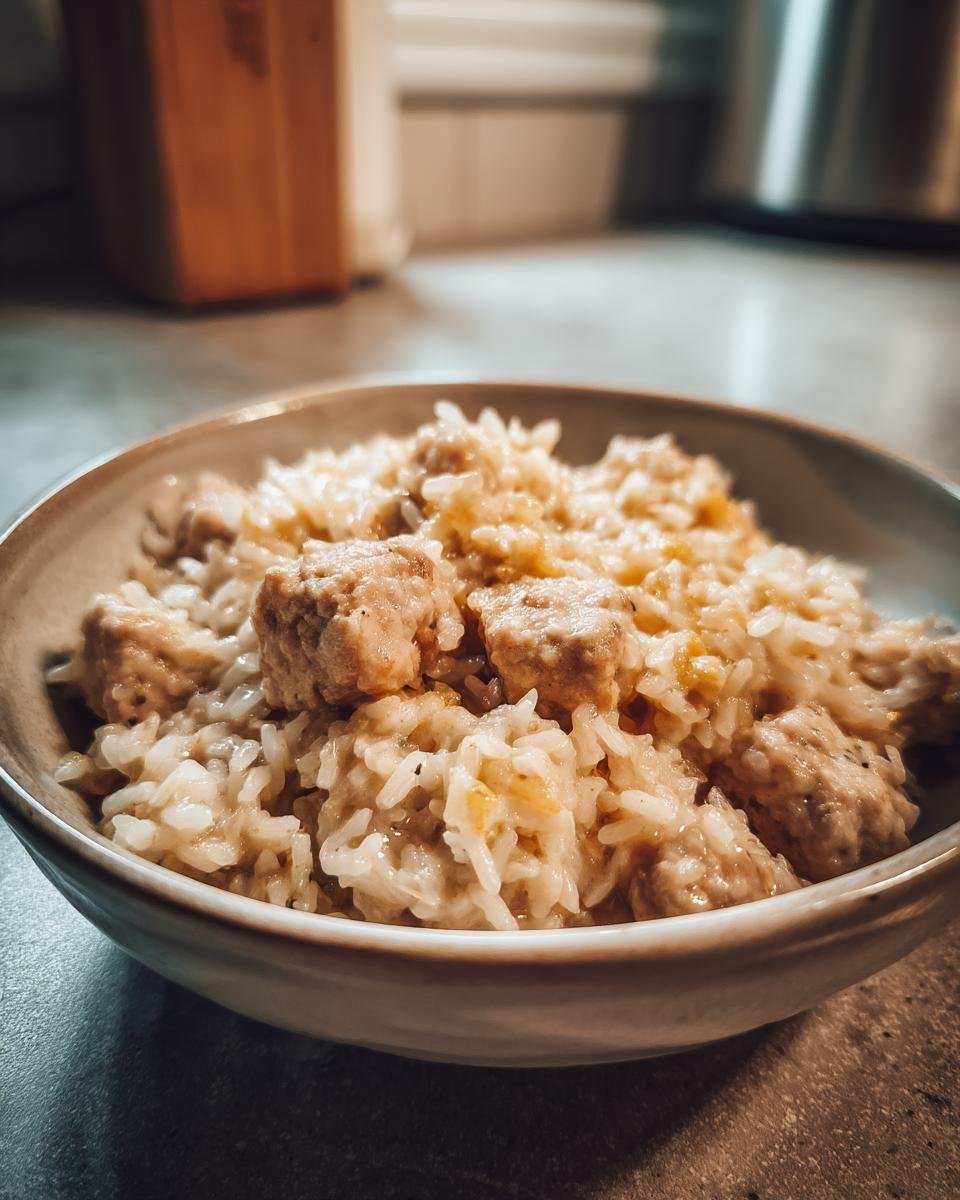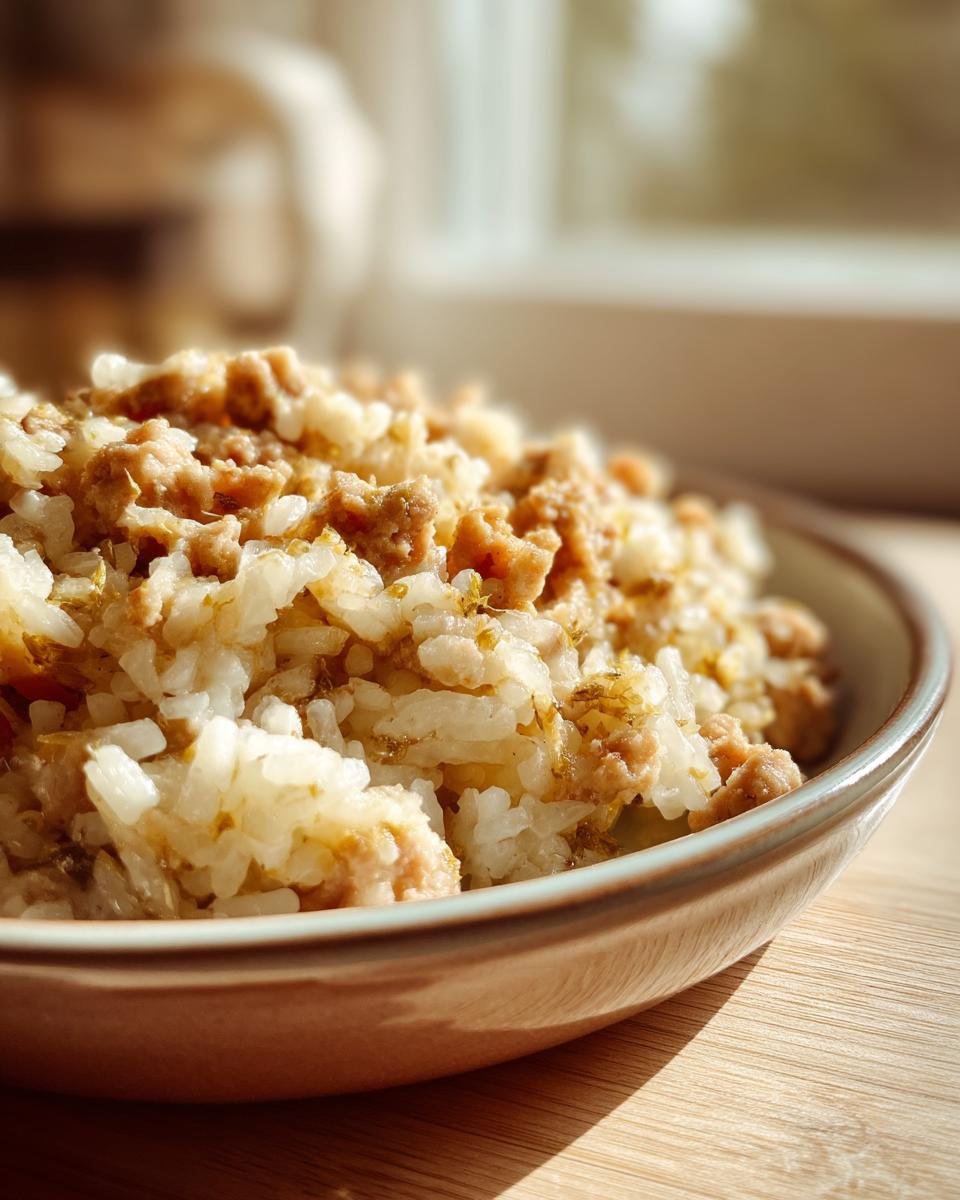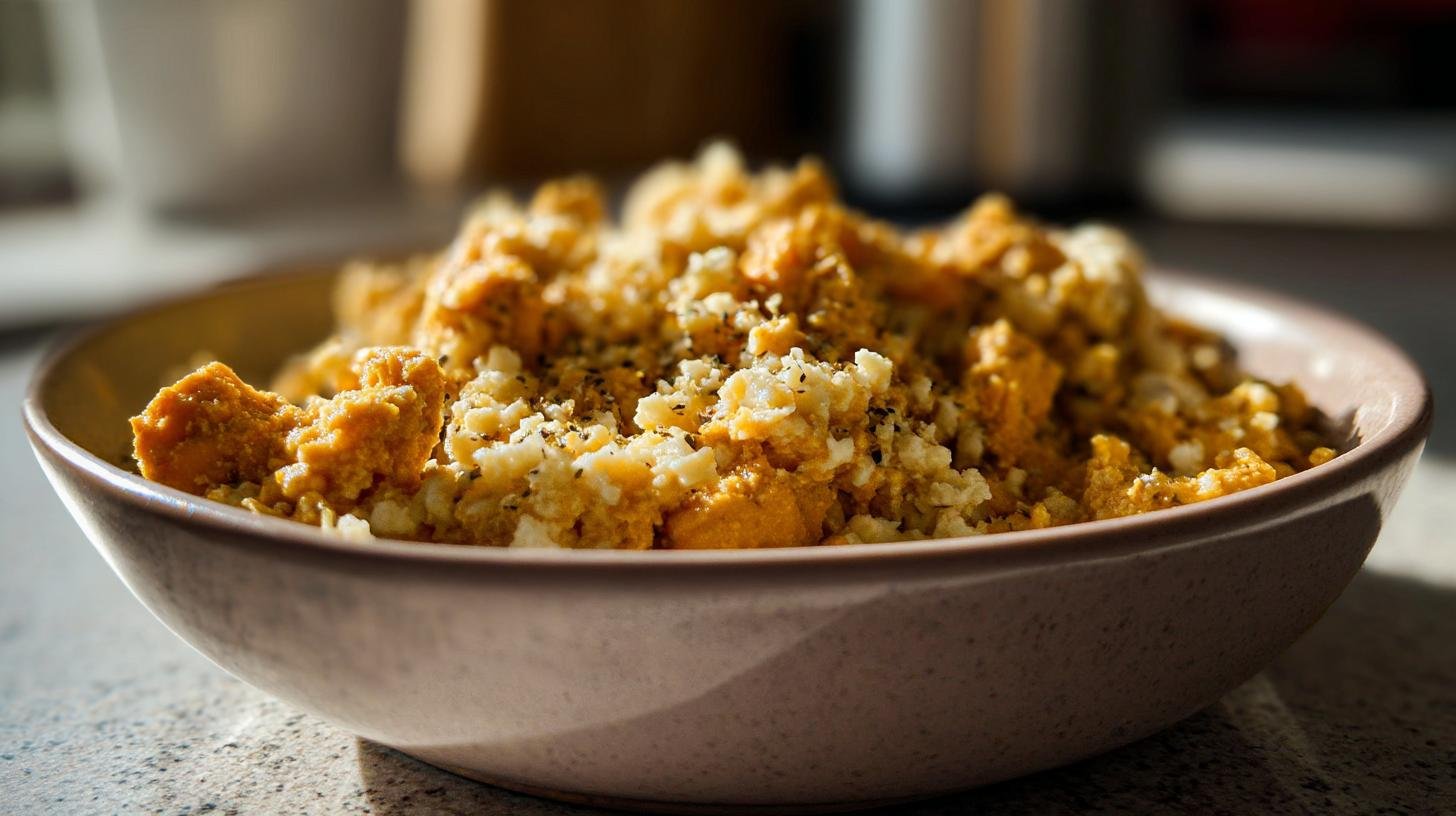Let me tell you about the night I became a puppy food detective. There I was at 2 AM, scrubbing diarrhea off my white rug while my new golden retriever pup, Buddy, whimpered in his crate. His third vet visit that month revealed what I’d feared – his sensitive tummy couldn’t handle commercial kibble. After ten years developing pet nutrition plans and working with veterinary teams, I thought I knew it all. But watching Buddy struggle taught me what textbooks couldn’t: how to create puppy food for sensitive digestion that actually works.
This recipe became our lifeline after three months of trial-and-error with my vet. We needed something gentle enough for developing digestive systems but packed with nutrients for growth. The secret? A balance of lean protein, gut-soothing pumpkin, and easily digestible carbs that won’t irritate delicate puppy bellies. I’ve since shared this formula with countless clients whose pups went from constant upset to thriving – one even started doing “happy spins” before mealtimes!
What makes this different from other homemade puppy foods? It’s not just about avoiding irritants (though we do that too). We’re strategically using ingredients like fish oil for brain development and yogurt probiotics tailored for puppies. Every element serves a purpose, measured precisely for growing dogs. Trust me – when your pup finally keeps a meal down and those tail wags return, you’ll want to hug this recipe like I did!
Ingredients for Puppy Food for Sensitive Digestion
Let me break down exactly what you’ll need – this isn’t the time for improvisation. After Buddy’s third round of tummy troubles, my vet drilled this into me: cooked lean ground turkey (unseasoned) is our MVP. Not chicken, not beef – turkey’s lower fat content makes it gentler on delicate systems. You’ll want the 93% lean variety, drained so thoroughly there’s zero grease left.
The pureed pumpkin (unsweetened) needs to be the plain canned stuff – not pie filling! That orange magic acts like a sponge in upset tummies. For the plain Greek yogurt (no additives), check labels twice – even “natural” brands sometimes hide sneaky sweeteners. I learned the hard way when Buddy licked his bowl clean… then left me a “present” worthy of crime scene tape.
Stick to these exact specs like your pup’s health depends on it (because it does). We’ll talk safe swaps later, but for now – no creative substitutions!
How to Make Puppy Food for Sensitive Digestion
Let’s get cooking! I’ve burned through six batches perfecting this method – follow these steps closely to avoid my early mistakes (like the Great Yogurt Curdle Incident of 2022).
- Cook that turkey like it owes you money: Crumble 93% lean ground turkey into your skillet. No oil needed – we’re avoiding fat splatter. Cook until it’s drier than a desert breeze, breaking up every last pink chunk. Drain it in a colander, then press paper towels on top until they come away clean. Even a teaspoon of leftover grease can trigger puppy tummy fireworks.
- Rice right: Boil your white rice in plain water until it’s soft enough to squish between fingers – think “baby food texture.” I use a 2:1 water-to-rice ratio. Fluff it with a fork and let it cool slightly while you…
- Mix with love (and a wooden spoon): In your biggest bowl, combine turkey, rice, pumpkin, and yogurt. Here’s where most folks go wrong – mix by hand! Machines over-process the texture. You want distinct bits for gentle chewing, not gloppy mush.
- Liquid gold: Whisk fish oil into cooled broth first – this distributes it evenly. Drizzle over the mixture while folding gently. Pro tip: If your broth’s still warm, you’ll get yogurt clumps. Ask me how I know!
- The patience test: Spread the mixture thin on a baking sheet to cool faster. Test a pea-sized bite on your inner wrist – if it feels warmer than your skin, wait. Hungry puppy eyes are tough, but serving too hot could cause vomiting.
- Portion control: Use an ice cream scoop to divide into containers. Leave ½ inch headspace – the pumpkin expands slightly when frozen. I label each with date/time – after day three, even this magic mix becomes a bacteria risk.
Preparation Tips
That wooden spoon isn’t just for nostalgia – hand-mixing lets you feel the texture. Blenders destroy the rice’s structure that helps firm up stools. Plus, puppies need practice chewing! If it looks like baby food, you’ve gone too far.
Why This Puppy Food for Sensitive Digestion Works
This recipe isn’t random – it’s puppy gut science! After Buddy’s fifth poop analysis (yes, I became that person), my vet explained exactly why this combo calms angry tummies:

Balanced protein/fiber ratio
We use a strict 2:1 turkey-to-rice ratio for a reason. Too much protein overwhelms developing enzymes, while the pumpkin’s soluble fiber acts like a security blanket for irritated intestines. Buddy’s stool samples showed perfect form scores once we nailed this balance – his vet still uses them as “textbook examples” for clients!
No common allergens like wheat/dairy
Commercial puppy foods often use wheat glutens as cheap fillers. Our version skips all the big triggers – no dairy proteins (except yogurt’s predigested cultures), no soy, no mystery “meal.” When a client’s Labradoodle reacted to every kibble known to man, this recipe became his safe space. Three days later? Solid poops for the first time in months.
Promotes gut health through pumpkin probiotics
That orange puree does double duty. The fiber feeds good bacteria, while the yogurt adds live cultures specifically helpful for puppies. I once tried skipping the yogurt to save time – BIG mistake. Within hours, Buddy’s gassy serenades could’ve powered hot air balloons. Never again!
Essential Equipment
You’ll need just three trusty tools I keep by my stove 24/7: a big stainless steel mixing bowl (avoid plastic – it holds smells), nesting measuring cups for precise ratios, and glass containers with snap lids. Forget fancy gadgets – I once tried a colander for draining turkey and lost half the batch through the holes! Pro tip: Use wide, shallow containers for cooling – deep bowls trap heat and breed bacteria.
Ingredient Notes & Safe Substitutions
Let’s talk about playing it safe with substitutions – because I’ve seen well-meaning swaps turn into midnight cleanup disasters. Every ingredient here serves a specific purpose for delicate puppy guts.

Turkey Alternatives
When the grocery store was out of ground turkey during Thanksgiving week, I panicked. My vet approved boiled chicken breast as a backup – but there’s a catch! Chicken needs to be shredded fine (no chunks!) and all visible fat removed. While turkey remains ideal for its lower fat content, I’ve used this swap for three foster pups successfully. Never use dark meat – even a little extra fat can undo all our careful work.
Rice Options
Brown rice seems healthier, right? Not for sensitive pups! Its extra fiber acts like sandpaper in inflamed intestines. A client once ignored this advice and texted me photos of her Maltese’s mucus-covered stool – we’re talking nightmare fuel. Stick to plain white rice: the starch coats the stomach while being easy to break down. In a pinch, overcooked pasta (no salt!) can work temporarily, but rice remains the gold standard.
What about the pumpkin and yogurt? Those are non-negotiable. I tried substituting sweet potato once – Buddy’s resulting gas could’ve cleared a room. The yogurt’s specific probiotics (L. acidophilus) are crucial – human supplements won’t cut it. Trust me, this recipe works because every piece plays its part!
Storing Puppy Food for Sensitive Digestion
Let me tell you about the time I learned storage rules the hard way. I left a batch in a plastic tub for four days – the resulting smell could’ve woken the neighbors! Now I’m militant about these guidelines:
Glass containers only – plastic absorbs odors and hides bacteria. I use wide-mouth mason jars so I can scrape every last bit. Three days max in the fridge (set phone reminders!), though truthfully, I toss anything that smells vaguely like my college dorm fridge.
Freezing’s our secret weapon! Pour portions into ice cube trays – each cube is roughly ¼ cup. Once frozen, pop them into a labeled freezer bag. When Buddy gives me those “I’m starving” eyes, I thaw a cube overnight in the fridge (never microwave – that uneven heat breeds nasty microbes!).
Pro tip: Write dates in Sharpie on lids. I once fed month-old food thinking it was fresh… let’s just say we both regretted my terrible handwriting that night!
Nutritional Breakdown
Let’s geek out on numbers – my vet made me chart these like a middle school science project! Here’s what you’re feeding that precious pup (and why Buddy’s coat got so shiny):
| Nutrient | Per Serving |
|---|---|
| Calories | 200 |
| Protein | 12g |
| Carbohydrates | 20g |
| Fiber | 3g |
| Sugar | 2g |
| Fat | 8g |
| Sodium | 50mg |
Heads up: These numbers might shift slightly depending on your turkey’s leanness or pumpkin brand. I once compared three broth brands and found a 15mg sodium difference – hence the “approximate” disclaimer! Always cross-check with your vet if your pup needs specific dietary restrictions. Pro tip: That fish oil? It’s why Buddy’s coat went from dull to “showdog shiny” in six weeks!
Puppy Food for Sensitive Digestion FAQ
Let’s tackle those burning questions I get daily at the dog park – because yes, people literally stop me when they see Buddy’s glossy coat!
“Can I use raw turkey instead?”
Oh honey, no – and let me tell you why! Raw diets can be risky even for adult dogs, but puppies? Their immune systems are still building defenses. My vet friend once treated a litter with salmonella from raw turkey – three days of IV fluids and terrified owners. Cooking destroys harmful bacteria while making the protein easier to digest. Think of it as pre-processing their meal!
“How long to transition to this food?”
This isn’t a light switch – it’s a slow dance. Start with 25% new food mixed into their old kibble for two days, then 50% for three days. By day six, you should be at 100%. Rushing this caused Buddy’s worst diarrhea episode – we’re talking hourly bathroom trips that made me question my life choices. The 5-7 day rule lets gut bacteria adjust without revolt.
“Is fish oil essential?”
Those omega-3s aren’t just for shiny coats! They reduce inflammation in irritated intestines and support brain development. I briefly skipped it to save money – within a week, Buddy’s skin got flaky and his energy dipped. Now I call it “liquid gold.” If your pup hates the smell (rare!), try rubbing a drop on their paw – they’ll lick it off while grooming!
Final Thoughts
Seeing Buddy leap for his bowl instead of hiding under the couch? That’s the magic moment I want for you. This puppy food for sensitive digestion changed our lives, but remember – every pup’s different. Snap a photo of your first batch and text it to your vet (mine still laughs about my “puppy food progress reports”).
When you spot those first solid poops or hear that contented post-meal sigh, come back and tell me! Your stories in the comments fuel my late-night recipe testing. Now go hug your pup – and maybe stock up on paper towels just in case!
Print
3-Step Puppy Food for Sensitive Digestion Stops Tummy Pain
- Total Time: 30 minutes
- Yield: 4 cups 1x
- Diet: Low Fat
Description
A gentle, homemade recipe designed for puppies with sensitive digestion. This easy-to-digest meal supports healthy growth and soothes upset stomachs with simple, natural ingredients.
Ingredients
- 1 cup cooked lean ground turkey (unseasoned)
- 1/2 cup cooked white rice
- 1/4 cup pureed pumpkin (unsweetened)
- 1 tbsp plain Greek yogurt (no additives)
- 1 tsp fish oil (for omega fatty acids)
- 1/4 cup low-sodium chicken broth (cooled)
Instructions
- Cook ground turkey thoroughly until no pink remains. Drain excess fat.
- Prepare white rice according to package instructions, using water only.
- Mix cooked turkey, rice, pumpkin puree, and yogurt in a bowl.
- Add fish oil and chicken broth, stirring until combined.
- Cool to room temperature before serving.
- Divide into portion-sized containers; refrigerate for up to 3 days.
Notes
- Consult your vet before changing your puppy’s diet
- Introduce new food gradually over 5-7 days
- Avoid onions, garlic, and spices
- Monitor stool consistency and energy levels
- Freeze portions for longer storage
- Prep Time: 10 minutes
- Cook Time: 20 minutes
- Category: Pet Food
- Method: Homemade
- Cuisine: Pet Food
Nutrition
- Serving Size: 1/2 cup
- Calories: 200
- Sugar: 2g
- Sodium: 50mg
- Fat: 8g
- Saturated Fat: 2g
- Unsaturated Fat: 5g
- Trans Fat: 0g
- Carbohydrates: 20g
- Fiber: 3g
- Protein: 12g
- Cholesterol: 30mg

